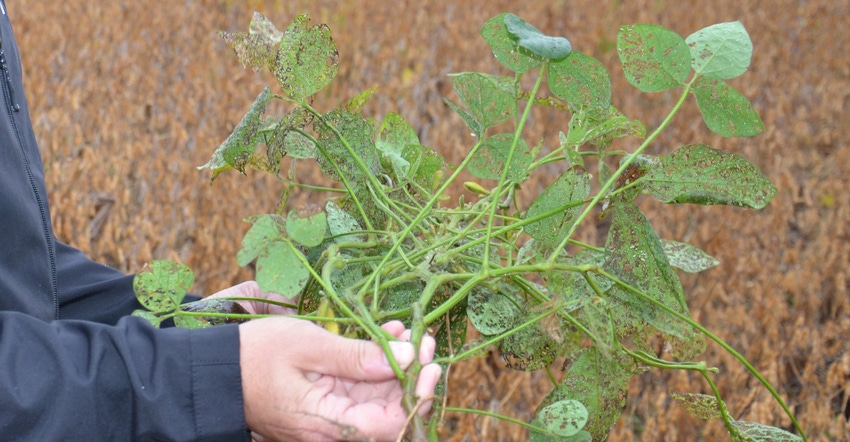July 29, 2021

Some of our soybeans have green stems with dry beans each year. Is this due to disease?
The Indiana certified crop adviser panel answering this question includes Traci Bultemeier, an agronomist with Pioneer near Fort Wayne; Jesse Grogan, a retired agronomist based in Lafayette; and Bryan Overstreet, an Extension ag educator for Purdue University Extension in Jasper County.
Bultemeier: One reason might be from what’s truly considered green stem syndrome. The majority of plants may be greenish; however, leaves are generally gone and grain moisture is within harvestable ideals. Often, moisture can be overly dry because a grower assumes the field isn’t ready. GSS can also have green pods, empty pods and even green leaves, yet there are pods on the same stem that are harvestable. There are still several theories about the cause of GSS. None leads directly or consistently to GSS; hence, it’s something that we will learn to deal with for now.
A second reason is plant health and yield potential. Where a group of plants are green, one might find only a few pods. The source sink relationship is out of whack. There are not enough soybean seeds on that plant to use up the energy that a green plant can produce. Providing optimal growing conditions with insecticide, fungicide, irrigation, variety selection and population can reduce the amount of flower and pod abortion during the growing season, leading to more mature pods per stem.
A third scenario could be from diseases or insects — particularly bean pod mottle virus, soybean aphids, thrips, stinkbugs, leafhoppers, bean leaf beetles or cercospora leaf blight. These reasons may tend toward having more brown plants then green-stemmed plants, but not always. A good insecticide works wonders, and it’s inexpensive when added to the fungicide pass.
Grogan: A primary cause is stress from drought, weather and field conditions in the early pod-fill stages. Plant hormones are activated to keep the leaves and stems green and functioning even though photoperiod response is to mature seed pods, especially when field conditions are good near harvest. Usually, it’s related to pod loss during stress periods, so plants are cued to fill the demand of lost pods. Green stem syndrome in individual plants or clusters of plants can also be caused by insect feeding and/or virus transmission. Anything to reduce stress in early pod development will help reduce green stem, such as insecticide and/or fungicide applications.
Late, off-label applications of glyphosate are known to also cause green stem and delayed harvest. A few varieties are more predisposed to green stem than others, although it is difficult to assess in all varieties. So, a variety recommendation from your seed representative is helpful. Strobilurin fungicides are known to cause a greening effect that persists for about four to seven days beyond normal harvest dates. Find a detailed account of green stem conditions and causes at bit.ly/green-stem-syndrome.
Overstreet: Some call this green stem syndrome. It has been blamed on several different causes. My personal thought is that for years, we thought the soybean plant was mature, but really, it just died. Now with healthier plants, they are really trying to mature. Plant viruses, low moisture, insect damage and potassium deficiency have all been looked at for causes. Most years it’s hard to say one thing did it. Make sure your potassium levels are good, and scout for insects and disease issues throughout the year.
You May Also Like




